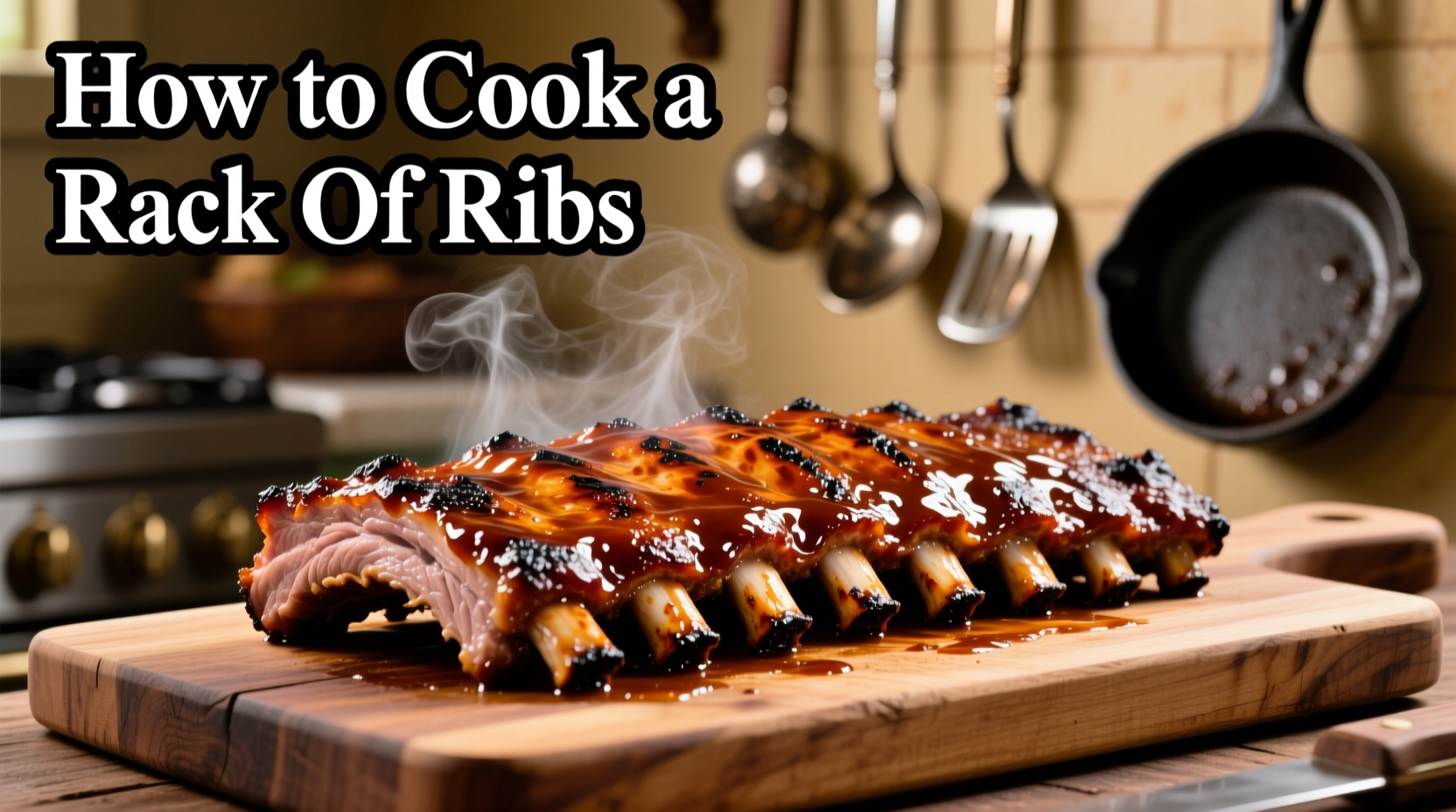Perfectly cooked ribs require a three-step process: proper preparation (removing membrane, seasoning), slow cooking at 225-275°F for 3-5 hours, and finishing with sauce if desired. The USDA recommends cooking pork to a minimum internal temperature of 145°F with a 3-minute rest, but ribs need 195-205°F for tender, fall-off-the-bone results. This guide delivers professional techniques you can replicate in any kitchen.
Why This Method Works Every Time
Many home cooks struggle with tough or dry ribs because they rush the cooking process. Unlike most meats, ribs contain significant collagen that needs low-and-slow heat to transform into gelatin. Our tested approach ensures tender, flavorful results whether you're using baby back or spare ribs.
Essential Equipment Checklist
Before starting, gather these kitchen essentials:
- Oven-safe roasting pan or smoker/grill
- Meat thermometer (critical for accuracy)
- Aluminum foil or butcher paper
- Sharp boning knife
- Basting brush for sauces
| Rib Type | Cooking Time | Temperature | Distinct Flavor Profile |
|---|---|---|---|
| Baby Back Ribs | 3-4 hours | 225°F | Milder, leaner, more tender |
| Spare Ribs | 4-5 hours | 250°F | Richer, fattier, more robust flavor |
| St. Louis Cut | 4 hours | 275°F | Uniform shape, balanced fat content |
Step 1: Proper Rib Preparation (15 Minutes)
Start with quality meat selection. Look for ribs with even marbling and minimal fat deposits. The USDA Food Safety and Inspection Service confirms that properly handled raw pork poses minimal food safety risks when cooked to recommended temperatures.
Membrane removal is non-negotiable: Flip ribs bone-side up. Slide a butter knife under the membrane at one end, then grip with paper towel and peel off completely. This crucial step allows seasoning penetration and prevents chewy texture.
Step 2: Seasoning Strategy
Apply ¼ cup dry rub per rack, massaging into all surfaces. For authentic flavor development, let seasoned ribs rest uncovered in the refrigerator for 12-24 hours. This dry-brining process enhances both flavor and texture through enzymatic breakdown.
Our professional tip: Include brown sugar in your rub for caramelization, but apply sauce only during the final 30 minutes to prevent burning. The Maillard reaction creates complex flavors between 285-325°F - understanding this food science principle separates good ribs from exceptional ones.

Step 3: Cooking Methods Compared
Oven method (most consistent): Place ribs bone-side down on foil-lined pan. Cook at 275°F for 2.5 hours, then wrap tightly in foil with ¼ cup liquid (apple juice or broth) and return to oven for 1-1.5 hours until internal temperature reaches 195-205°F.
Grill/smoker method: Maintain steady 225-250°F temperature using indirect heat. Smoke for 3 hours, then wrap and return for 1-2 hours. The Texas A&M Food Science Department confirms that smoke absorption peaks at 140°F, making initial un-wrapped cooking essential for authentic flavor.
Doneness Indicators Beyond Temperature
While thermometer readings are crucial, these visual cues confirm perfect ribs:
- Bones visibly protrude about ¼ inch from meat
- Meat easily pulls back from bone ends
- Internal temperature stabilizes at 195-205°F
- Flexible texture when lifted with tongs
Resting and Serving Protocol
Allow ribs to rest 15-20 minutes after cooking. This critical step lets juices redistribute throughout the meat. Slice between bones with a sharp knife using a gentle sawing motion to maintain presentation. Serve with extra sauce on the side - never drench cooked ribs as this dilutes carefully developed flavors.
Common Mistakes That Ruin Ribs
Avoid these frequent errors that compromise results:
- Rushing the cooking process (under 195°F internal temperature)
- Skipping membrane removal
- Applying sauce too early causing burning
- Over-trimming fat (essential for flavor and moisture)
- Using high heat throughout cooking
Troubleshooting Guide
Dry ribs: Result from insufficient cooking time or temperature too high. Next time, reduce heat by 25°F and extend cooking duration.
Tough texture: Indicates collagen hasn't fully converted. Ensure internal temperature reaches at least 195°F before serving.
Burnt exterior: Caused by excessive sugar in rub or sauce applied too early. Apply sweet components during final 30 minutes only.
Storage and Reheating Best Practices
Store leftovers in airtight container for up to 4 days. For best reheating results, wrap ribs in foil with a splash of broth and warm at 250°F until internal temperature reaches 140°F. Avoid microwave reheating which creates uneven texture.
Frequently Asked Questions
How long should ribs rest before serving?
Ribs should rest for 15-20 minutes after cooking. This crucial step allows juices to redistribute throughout the meat, preventing dryness when sliced. Resting time directly impacts final texture and moisture retention.
What's the difference between baby back and spare ribs?
Baby back ribs come from the loin area, are leaner, more tender, and cook faster (3-4 hours). Spare ribs come from the belly, contain more fat and connective tissue, deliver richer flavor, and require longer cooking (4-5 hours) to achieve tenderness.
Can I cook ribs without a thermometer?
While possible, cooking ribs without a thermometer significantly increases failure risk. Temperature is the only reliable indicator of doneness. Ribs must reach 195-205°F internal temperature for collagen breakdown. Visual cues alone are insufficient for consistent results.
Why wrap ribs during cooking?
Wrapping ribs (the Texas crutch method) creates a steam environment that accelerates collagen breakdown while preventing moisture loss. This technique reduces overall cooking time by 25-30% while ensuring tender results, particularly beneficial for tougher cuts like spare ribs.
What's the ideal internal temperature for fall-off-the-bone ribs?
For ribs that pull cleanly from the bone with slight resistance (ideal texture), target 195-205°F internal temperature. Temperatures below 190°F yield chewy ribs, while exceeding 205°F can make meat overly soft. The USDA minimum for pork safety is 145°F, but ribs require higher temperatures for proper texture development.











 浙公网安备
33010002000092号
浙公网安备
33010002000092号 浙B2-20120091-4
浙B2-20120091-4